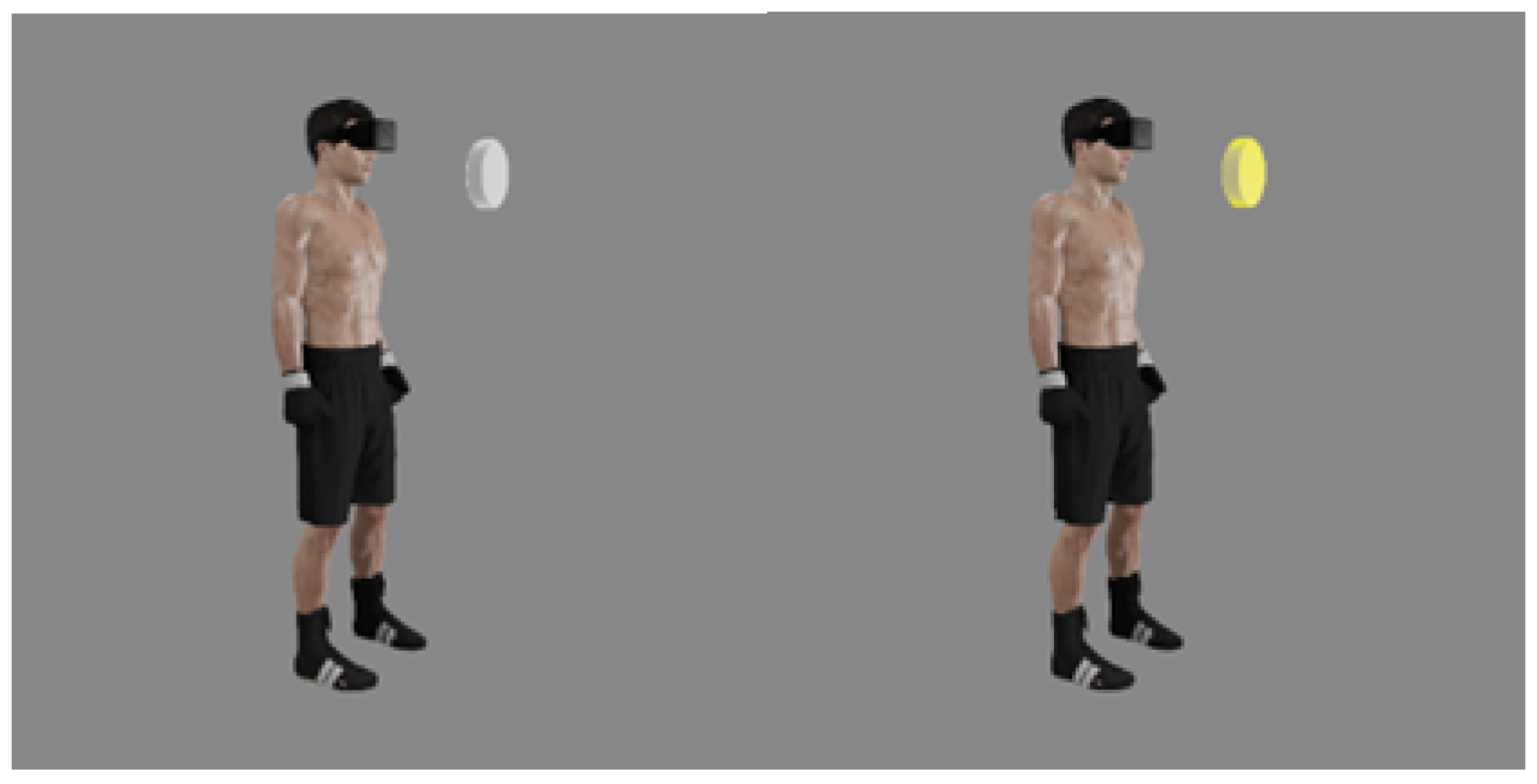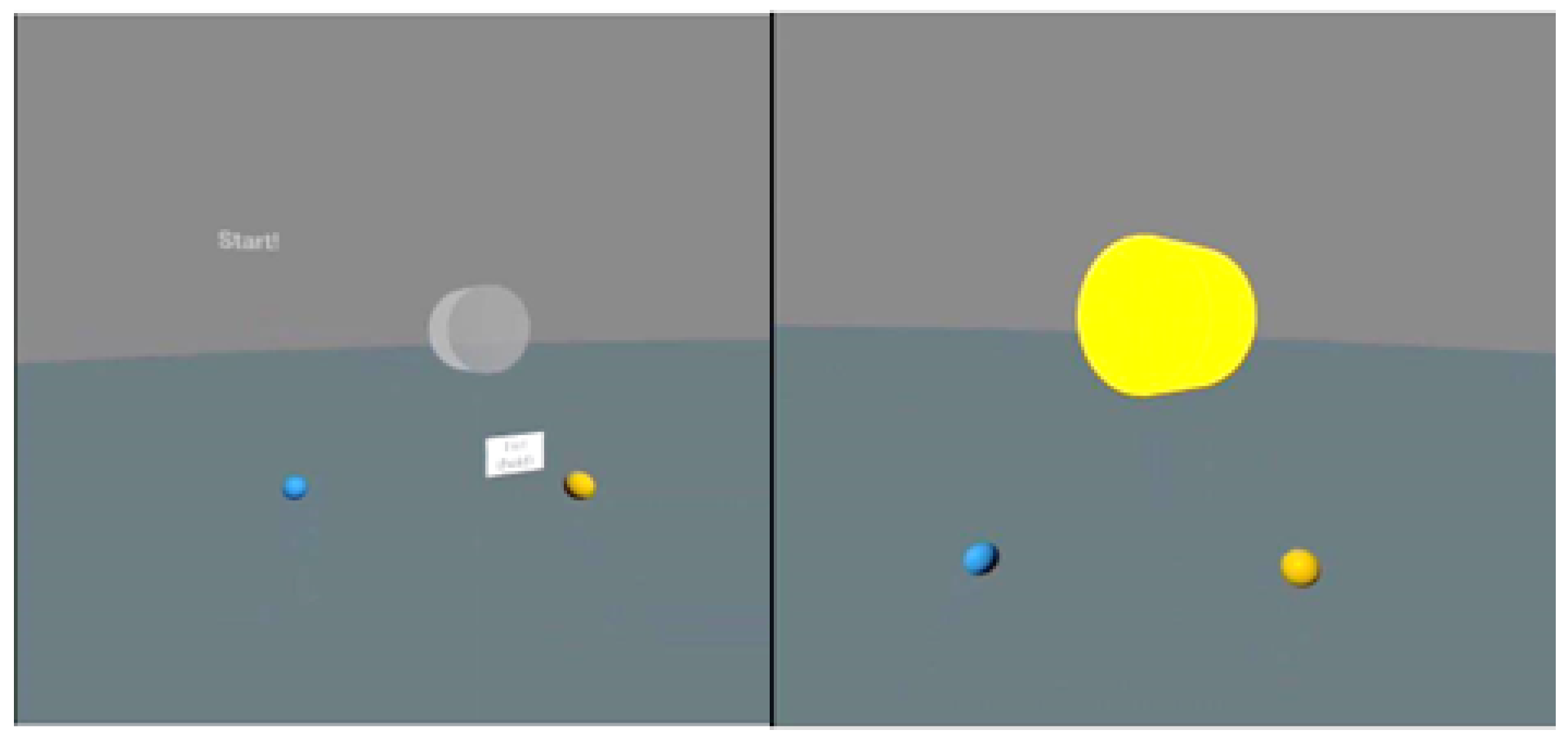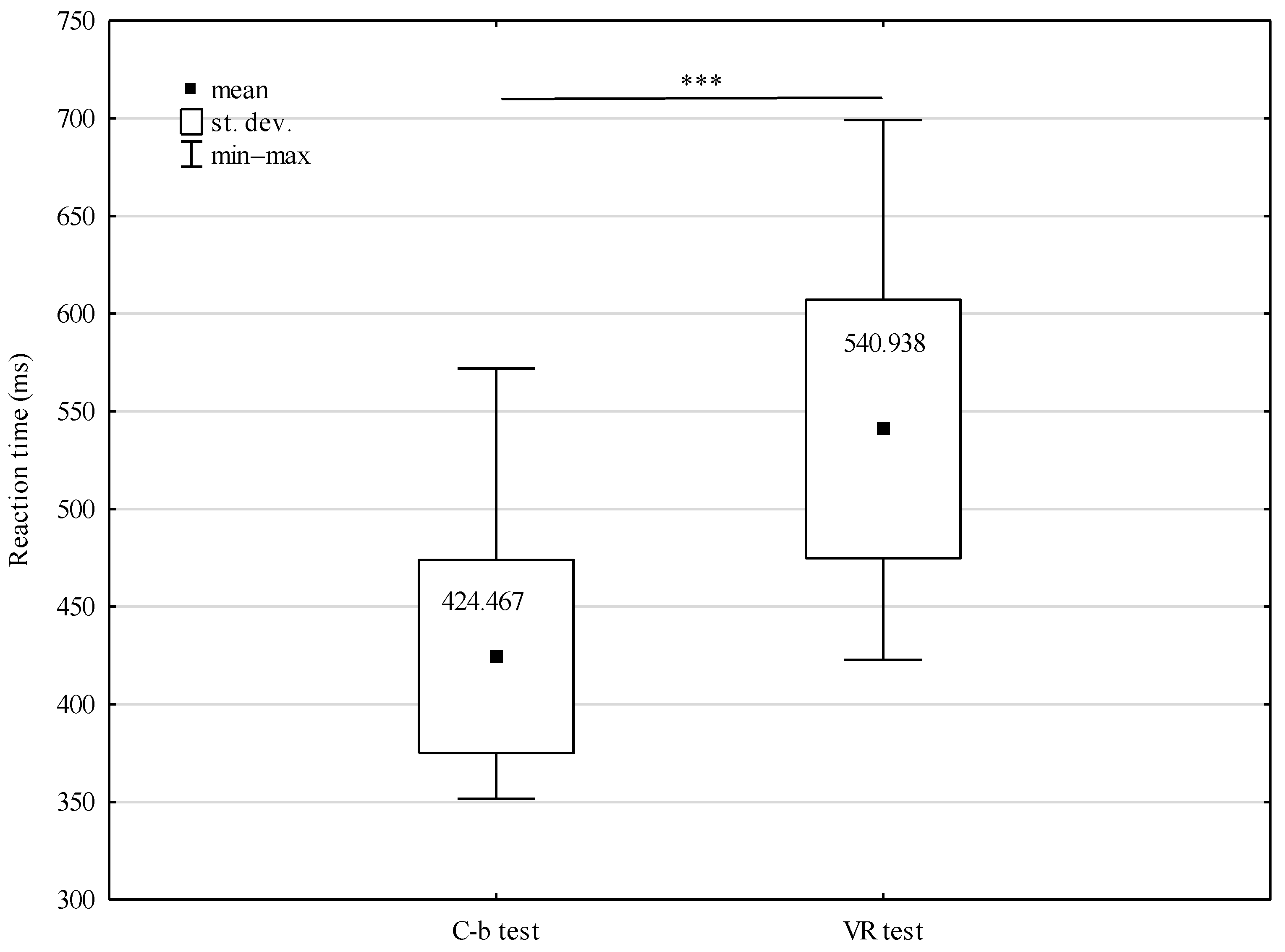Assessment of the Relevance and Reliability of Reaction Time Tests Performed in Immersive Virtual Reality by Mixed Martial Arts Fighters
Abstract
:1. Introduction
2. Materials and Methods
3. Results
4. Discussion
5. Limitations
6. Conclusions
Author Contributions
Funding
Institutional Review Board Statement
Informed Consent Statement
Data Availability Statement
Acknowledgments
Conflicts of Interest
References
- Carvalho, B.; Soares, M.M.; Neves, A.; Soares, G.; Lins, A. Virtual Reality Devices Applied to Digital Games: A Literature Review. Ergon. Des. Methods Tech. 2016, 125–141. [Google Scholar]
- Van Dam, A.; Laidlaw, D.H.; Simpson, R.M. Experiments in Immersive Virtual Reality for Scientific Visualization. Comput. Graph. 2002, 26, 535–555. [Google Scholar] [CrossRef] [Green Version]
- Monterubbianesi, R.; Tosco, V.; Vitiello, F.; Orilisi, G.; Fraccastoro, F.; Putignano, A.; Orsini, G. Augmented, Virtual and Mixed Reality in Dentistry: A Narrative Review on the Existing Platforms and Future Challenges. Appl. Sci. 2022, 12, 877. [Google Scholar] [CrossRef]
- Moussa, R.; Alghazaly, A.; Althagafi, N.; Eshky, R.; Borzangy, S. Effectiveness of Virtual Reality and Interactive Simulators on Dental Education Outcomes: Systematic Review. Eur. J. Dent. 2022, 16, 14–31. [Google Scholar] [CrossRef] [PubMed]
- Ma, D.; Gausemeier, J.; Fan, X.; Grafe, M. Virtual Reality & Augmented Reality in Industry; Springer: Berlin/Heidelberg, Germany, 2011. [Google Scholar]
- Buettner, R.; Baumgartl, H.; Konle, T.; Haag, P. A Review of Virtual Reality and Augmented Reality Literature in Healthcare. In Proceedings of the 2020 IEEE Symposium on Industrial Electronics Applications (ISIEA), Online, 17–18 July 2020; pp. 1–6. [Google Scholar]
- Campo-Prieto, P.; Rodríguez-Fuentes, G.; Cancela-Carral, J.M. Can Immersive Virtual Reality Videogames Help Parkinson’s Disease Patients? A Case Study. Sensors 2021, 21, 4825. [Google Scholar] [CrossRef]
- Mazurek, J.; Kiper, P.; Cieślik, B.; Rutkowski, S.; Mehlich, K.; Turolla, A.; Szczepańska-Gieracha, J. Virtual Reality in Medicine: A Brief Overview and Future Research Directions. Hum. Mov. 2019, 20, 16–22. [Google Scholar] [CrossRef] [Green Version]
- Pillai, A.S.; Mathew, P.S. Impact of Virtual Reality in Healthcare: A Review. Available online: https://www.igi-global.com/chapter/impact-of-virtual-reality-in-healthcare/215819 (accessed on 22 January 2022).
- Samadbeik, M.; Yaaghobi, D.; Bastani, P.; Abhari, S.; Rezaee, R.; Garavand, A. The Applications of Virtual Reality Technology in Medical Groups Teaching. J. Adv. Med. Educ. Prof. 2018, 6, 123–129. [Google Scholar] [CrossRef]
- Stanica, I.-C.; Moldoveanu, F.; Portelli, G.-P.; Dascalu, M.-I.; Moldoveanu, A.; Ristea, M.G. Flexible Virtual Reality System for Neurorehabilitation and Quality of Life Improvement. Sensors 2020, 20, 6045. [Google Scholar] [CrossRef]
- Hamilton, D.; McKechnie, J.; Edgerton, E.; Wilson, C. Immersive Virtual Reality as a Pedagogical Tool in Education: A Systematic Literature Review of Quantitative Learning Outcomes and Experimental Design. J. Comput. Educ. 2021, 8, 1–32. [Google Scholar] [CrossRef]
- Radianti, J.; Majchrzak, T.A.; Fromm, J.; Wohlgenannt, I. A Systematic Review of Immersive Virtual Reality Applications for Higher Education: Design Elements, Lessons Learned, and Research Agenda. Comput. Educ. 2020, 147, 103778. [Google Scholar] [CrossRef]
- Campo-Prieto, P.; Cancela-Carral, J.M.; Rodríguez-Fuentes, G. Wearable Immersive Virtual Reality Device for Promoting Physical Activity in Parkinson’s Disease Patients. Sensors 2022, 22, 3302. [Google Scholar] [CrossRef] [PubMed]
- Cao, L.; Peng, C.; Dong, Y. Ellic’s Exercise Class: Promoting Physical Activities during Exergaming with Immersive Virtual Reality. Virtual Real. 2021, 25, 597–612. [Google Scholar] [CrossRef]
- Dębska, M.; Polechoński, J.; Mynarski, A.; Polechoński, P. Enjoyment and Intensity of Physical Activity in Immersive Virtual Reality Performed on Innovative Training Devices in Compliance with Recommendations for Health. Int. J. Environ. Res. Public Health 2019, 16, 3673. [Google Scholar] [CrossRef] [PubMed] [Green Version]
- Polechoński, J.; Nierwińska, K.; Kalita, B.; Wodarski, P. Can Physical Activity in Immersive Virtual Reality Be Attractive and Have Sufficient Intensity to Meet Health Recommendations for Obese Children? A Pilot Study. Int. J. Environ. Res. Public Health 2020, 17, 8051. [Google Scholar] [CrossRef]
- Zhou, S. Using Virtual Reality to Promote Physical Activity. J. Softw. Eng. Appl. 2020, 13, 312–326. [Google Scholar] [CrossRef]
- Zhang, X.; Shi, Y.; Bai, H. Immersive Virtual Reality Physical Education Instructional Patterns on the Foundation of Vision Sensor. J. Sens. 2021, 2021, e7752447. [Google Scholar] [CrossRef]
- Bauer, A.C.M.; Andringa, G. The Potential of Immersive Virtual Reality for Cognitive Training in Elderly. Gerontology 2020, 66, 614–623. [Google Scholar] [CrossRef]
- Wojciechowski, A.; Wiśniewska, A.; Pyszora, A.; Liberacka-Dwojak, M.; Juszczyk, K. Virtual Reality Immersive Environments for Motor and Cognitive Training of Elderly People—A Scoping Review. Hum. Technol. 2021, 17, 145–163. [Google Scholar] [CrossRef]
- Akbaş, A.; Marszałek, W.; Kamieniarz, A.; Polechoński, J.; Słomka, K.J.; Juras, G. Application of Virtual Reality in Competitive Athletes—A Review. J. Hum. Kinet. 2019, 69, 5. [Google Scholar] [CrossRef] [Green Version]
- Bideau, B.; Kulpa, R.; Vignais, N.; Brault, S.; Multon, F.; Craig, C. Using Virtual Reality to Analyze Sports Performance. IEEE Comput. Graph. Appl. 2010, 30, 14–21. [Google Scholar] [CrossRef]
- Qian, J.; McDonough, D.J.; Gao, Z. The Effectiveness of Virtual Reality Exercise on Individual’s Physiological, Psychological and Rehabilitative Outcomes: A Systematic Review. Int. J. Environ. Res. Public Health 2020, 17, 4133. [Google Scholar] [CrossRef]
- Todorov, K.; Manolova, A.; Chervendinev, G. Immersion in Virtual Reality Video Games for Improving Physical Performance Measures: A Review. In Proceedings of the 2019 27th National Conference with International Participation (℡ECOM), Sofia, Bulgaria, 30–31 October 2019; pp. 35–38. [Google Scholar]
- Bird, J.M.; Karageorghis, C.I.; Baker, S.J.; Brookes, D.A.; Nowicky, A.V. Ready Exerciser One: Effects of Music and Virtual Reality on Cycle Ergometer Exercise. Br. J. Health Psychol. 2021, 26, 15–32. [Google Scholar] [CrossRef]
- McClure, C.; Schofield, D. Running Virtual: The Effect of Virtual Reality on Exercise. J. Hum. Sport Exerc. 2019, 15, 861–870. [Google Scholar] [CrossRef]
- Shoib, N.A.; Sunar, M.S.; Nor, N.N.M.; Azman, A.; Jamaludin, M.N.; Latip, H.F.M. Rowing Simulation Using Rower Machine in Virtual Reality. In Proceedings of the 2020 6th International Conference on Interactive Digital Media (ICIDM), Online, 14–15 December 2020; pp. 1–6. [Google Scholar]
- Zeng, N.; Liu, W.; Pope, Z.C.; McDonough, D.J.; Gao, Z. Acute Effects of Virtual Reality Exercise Biking on College Students’ Physical Responses. Res. Q. Exerc. Sport 2021. [Google Scholar] [CrossRef]
- Jochymczyk-Woźniak, K.; Nowakowska, K.; Polechoński, J.; Sładczyk, S.; Michnik, R. Physiological Gait versus Gait in VR on Multidirectional Treadmill—Comparative Analysis. Medicina 2019, 55, 517. [Google Scholar] [CrossRef] [Green Version]
- Wodarski, P.; Jurkojć, J.; Bieniek, A.; Chrzan, M.; Michnik, R.; Polechoński, J.; Gzik, M. The Analysis of the Influence of Virtual Reality on Parameters of Gait on a Treadmill According to Adjusted and Non-Adjusted Pace of the Visual Scenery. In Proceedings of the Information Technology in Biomedicine, Kamień Śląski, Poland, 18–20 June 2019; Pietka, E., Badura, P., Kawa, J., Wieclawek, W., Eds.; Springer International Publishing: Cham, Switzerland, 2019; pp. 543–553. [Google Scholar]
- Wodarski, P.; Jurkojć, J.; Polechoński, J.; Bieniek, A.; Chrzan, M.; Michnik, R.; Gzik, M. Assessment of Gait Stability and Preferred Walking Speed in Virtual Reality. Acta Bioeng. Biomech. 2020, 22, 127–134. [Google Scholar] [CrossRef]
- Holden, J.; Francisco, E.; Lensch, R.; Tommerdahl, A.; Kirsch, B.; Zai, L.; Dennis, R.; Tommerdahl, M. Accuracy of Different Modalities of Reaction Time Testing: Implications for Online Cognitive Assessment Tools. bioRxiv 2019. [Google Scholar] [CrossRef] [Green Version]
- Vahle, N.M.; Unger, S.; Tomasik, M.J. Reaction Time-Based Cognitive Assessments in Virtual Reality—A Feasibility Study with an Age Diverse Sample. Stud. Health Technol. Inform. 2021, 283, 139–145. [Google Scholar] [CrossRef]
- Kranzler, J.H. Mental Chronometry. In Encyclopedia of the Sciences of Learning; Seel, N.M., Ed.; Springer US: Boston, MA, USA, 2012; pp. 2180–2182. ISBN 978-1-4419-1428-6. [Google Scholar]
- Jensen, A.R. Process Differences and Individual Differences in Some Cognitive Tasks. Intelligence 1987, 11, 107–136. [Google Scholar] [CrossRef]
- Batra, A.; Vyas, S.; Gupta, J.; Gupta, K.; Hada, R. A Comparative Study Between Young and Elderly Indian Males on Audio-Visual Reaction Time. Indian J. Sci. Res. Technol. 2014, 2, 25–29. [Google Scholar]
- Nuri, L.; Shadmehr, A.; Ghotbi, N.; Attarbashi Moghadam, B. Reaction Time and Anticipatory Skill of Athletes in Open and Closed Skill-Dominated Sport. Eur. J. Sport Sci. 2013, 13, 431–436. [Google Scholar] [CrossRef]
- Pavelka, R.; Třebický, V.; Třebická Fialová, J.; Zdobinský, A.; Coufalová, K.; Havlíček, J.; Tufano, J.J. Acute Fatigue Affects Reaction Times and Reaction Consistency in Mixed Martial Arts Fighters. PLoS ONE 2020, 15, e0227675. [Google Scholar] [CrossRef]
- Ignatjeva, A.; Nitychoruk, M.; Terbalyan, A.; Langer, A.; Wacek, A.; Maszczyk, A. The Effect of the Dynamics of External Load Changes in the Aspect of the Lower Limit Response Time of the Competitors of Mixed Martial Arts (MMA) Taking into Account Weight Categories and Sport Experience. Balt. J. Health Phys. Act. 2021, 13, 1–10. [Google Scholar] [CrossRef]
- Klocek, T.; Spieszny, M.; Szczepanik, M. Computer Tests of Coordination Abilities; COS: Warszawa, Poland, 2002. [Google Scholar]
- Koo, T.K.; Li, M.Y. A Guideline of Selecting and Reporting Intraclass Correlation Coefficients for Reliability Research. J. Chiropr. Med. 2016, 15, 155–163. [Google Scholar] [CrossRef] [Green Version]
- Shrout, P.E.; Fleiss, J.L. Intraclass Correlations: Uses in Assessing Rater Reliability. Psychol. Bull. 1979, 86, 420. [Google Scholar] [CrossRef]
- Cole, W.R.; Arrieux, J.P.; Schwab, K.; Ivins, B.J.; Qashu, F.M.; Lewis, S.C. Test–Retest Reliability of Four Computerized Neurocognitive Assessment Tools in an Active Duty Military Population. Arch. Clin. Neuropsychol. 2013, 28, 732–742. [Google Scholar] [CrossRef]
- Lezak, M.D.; Howieson, D.B.; Bigler, E.D.; Tranel, D. Neuropsychological Assessment; Oxford University Press: Oxford, UK, 2012; ISBN 978-0-19-539552-5. [Google Scholar]
- Mukaka, M.M. A Guide to Appropriate Use of Correlation Coefficient in Medical Research. Malawi Med. J. 2012, 24, 69. [Google Scholar]
- Farnsworth, J.L., II; Dargo, L.; Ragan, B.G.; Kang, M. Reliability of Computerized Neurocognitive Tests for Concussion Assessment: A Meta-Analysis. J. Athl. Train. 2017, 52, 826–833. [Google Scholar] [CrossRef] [Green Version]
- Dos Santos Soares, E.; Corazza, S.T.; Piovesan, A.C.; de Azevedo, R.P.; Vasconcellos, S.J.L. Creation, Validation, and Reliability of a Shooting Simulator Instrument for Reaction Time Evaluation. Mot. Rev. Educ. Física 2016, 22, 277–282. [Google Scholar] [CrossRef] [Green Version]
- Lang, A. The Limited Capacity Model of Mediated Message Processing. J. Commun. 2000, 50, 46–70. [Google Scholar] [CrossRef]
- Badau, D.; Baydil, B.; Badau, A. Differences among Three Measures of Reaction Time Based on Hand Laterality in Individual Sports. Sports 2018, 6, 45. [Google Scholar] [CrossRef] [PubMed] [Green Version]
- Barrett, K.; Barman, S.; Boitano, S.; Brooks, H. Ganong’s Review of Medical Physiology, 25th ed.; McGraw-Hill Education/Medical: New York, NY, USA, 2015; ISBN 978-0-07-182510-8. [Google Scholar]
- Al-Hashel, J.Y.; Ahmed, S.F.; Al-Mutairi, H.; Hassan, S.; Al-Awadhi, N.; Al-Saraji, M. Association of Cognitive Abilities and Brain Lateralization among Primary School Children in Kuwait. Neurosci. J. 2016, 2016, 6740267. [Google Scholar] [CrossRef] [PubMed] [Green Version]
- Boulinguez, P.; Barthélémy, S.; Debû, B. Influence of the Movement Parameter to Be Controlled on Manual RT Asymmetries in Right-Handers. Brain Cogn. 2000, 44, 653–661. [Google Scholar] [CrossRef]
- Darbutas, T.; Juodžbalienė, V.; Skurvydas, A.; Kriščiūnas, A. Dependence of Reaction Time and Movement Speed on Task Complexity and Age. Med. Kaunas Lith. 2013, 49, 18–22. [Google Scholar] [CrossRef]
- Yamauchi, M.; Imanaka, K.; Nakayama, M.; Nishizawa, S. Lateral Difference and Interhemispheric Transfer on Arm-Positioning Movement between Right and Left Handers. Percept. Mot. Skills 2004, 98, 1199–1209. [Google Scholar] [CrossRef]
- Asai, T.; Sugimori, E.; Tanno, Y. Two Agents in the Brain: Motor Control of Unimanual and Bimanual Reaching Movements. PLoS ONE 2010, 5, e10086. [Google Scholar] [CrossRef]
- Mieschke, P.E.; Elliott, D.; Helsen, W.F.; Carson, R.G.; Coull, J.A. Manual Asymmetries in the Preparation and Control of Goal-Directed Movements. Brain Cogn. 2001, 45, 129–140. [Google Scholar] [CrossRef] [Green Version]
- Boutios, S.; Fiorilli, G.; Buonsenso, A.; Daniilidis, P.; Centorbi, M.; Intrieri, M.; di Cagno, A. The Impact of Age, Gender and Technical Experience on Three Motor Coordination Skills in Children Practicing Taekwondo. Int. J. Environ. Res. Public. Health 2021, 18, 5998. [Google Scholar] [CrossRef]
- Chen, W.-Y.; Wu, S.K.; Song, T.-F.; Chou, K.-M.; Wang, K.-Y.; Chang, Y.-C.; Goodbourn, P.T. Perceptual and Motor Performance of Combat-Sport Athletes Differs According to Specific Demands of the Discipline. Percept. Mot. Skills 2017, 124, 293–313. [Google Scholar] [CrossRef]
- Cynarski, W.J.; Słopecki, J.; Dziadek, B.; Böschen, P.; Piepiora, P. Indicators of Targeted Physical Fitness in Judo and Jujutsu—Preliminary Results of Research. Int. J. Environ. Res. Public. Health 2021, 18, 4347. [Google Scholar] [CrossRef]
- Dariusz, G.; Zbigniew, B. Reliability and Accuracy of Batak Lite Tests Used for Assessing Coordination Motor Abilities in Wrestlers. Pol. J. Sport Tour. 2014, 21, 72–76. [Google Scholar]
- Gierczuk, D.; Bujak, Z.; Rowiński, J.; Dmitriyev, A. Selected Coordination Motor Abilities in Elite Wrestlers and Taekwon-Do Competitors. Pol. J. Sport Tour. 2012, 19, 230–234. [Google Scholar] [CrossRef] [Green Version]
- Sadowski, J. Dominant Coordination Motor Abilities in Combat Sports. Available online: https://www.semanticscholar.org/paper/Dominant-Coordination-Motor-Abilities-in-Combat-Sadowski/ceb18d9bd6e40c7c8b3848ed1cdfe2c6e069f839 (accessed on 22 January 2022).
- Neumann, D.L.; Moffitt, R.L.; Thomas, P.R.; Loveday, K.; Watling, D.P.; Lombard, C.L.; Antonova, S.; Tremeer, M.A. A Systematic Review of the Application of Interactive Virtual Reality to Sport. Virtual Real. 2018, 22, 183–198. [Google Scholar] [CrossRef] [Green Version]










| Type of Test | ICC | p |
|---|---|---|
| Simple reaction—right hand | 0.793 | 0.001 |
| Simple reaction—left hand | 0.836 | 0.001 |
| Complex reaction—right and left hand | 0.743 | 0.001 |
| Type of Test | ICC | p |
|---|---|---|
| Simple reaction—right hand | 0.730 | 0.001 |
| Simple reaction—left hand | 0.805 | 0.001 |
| Complex reaction—right and left hand | 0.801 | 0.001 |
Publisher’s Note: MDPI stays neutral with regard to jurisdictional claims in published maps and institutional affiliations. |
© 2022 by the authors. Licensee MDPI, Basel, Switzerland. This article is an open access article distributed under the terms and conditions of the Creative Commons Attribution (CC BY) license (https://creativecommons.org/licenses/by/4.0/).
Share and Cite
Polechoński, J.; Langer, A. Assessment of the Relevance and Reliability of Reaction Time Tests Performed in Immersive Virtual Reality by Mixed Martial Arts Fighters. Sensors 2022, 22, 4762. https://doi.org/10.3390/s22134762
Polechoński J, Langer A. Assessment of the Relevance and Reliability of Reaction Time Tests Performed in Immersive Virtual Reality by Mixed Martial Arts Fighters. Sensors. 2022; 22(13):4762. https://doi.org/10.3390/s22134762
Chicago/Turabian StylePolechoński, Jacek, and Alan Langer. 2022. "Assessment of the Relevance and Reliability of Reaction Time Tests Performed in Immersive Virtual Reality by Mixed Martial Arts Fighters" Sensors 22, no. 13: 4762. https://doi.org/10.3390/s22134762







